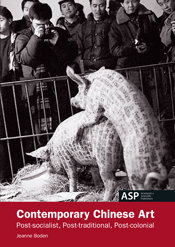Description
In the early 1990s artist Xu Bing stamped two pigs with respectively nonsensical Latin words and fake Chinese characters and allowed them to mate in an art gallery. The performance of ‘two creatures, devoid of human consciousness, yet carrying on their bodies the marks of human civilization’, engaging in the ‘most primal form of social intercourse’ confronted the public with the tension between nature and civilization. The work also addresses the tension between China and the West and therefore perfectly fits the core message of this book.
Contemporary art in China takes place in a post-socialist (post-Mao) context, and at the same time a post-traditional one, searching for balance between aesthetic legacy and modernization. It also tries to find its position in the post-colonial globalized arena.
This book explores the tension between individual artistic freedom and a dominant discourse of central Chinese government, between China’s cultural legacy and modernization, and between China and a global art world still dominated by a Western canon. As a case study it focuses on the artists who participated in the Venice Biennale in 1993, which was the first time contemporary art from mainland China was structurally invited to participate in a global art context.
Cover picture: Xu Bing, A Case Study of Transference, 1993–1994 © courtesy of Xu Bing
Reviews
中国当代艺术这个话题越来越成为国际学术界关注的内容,而包德贞教授是较早就对这一领域进行深入研究的国际学者。由于她深厚的西方学术训练背景和对中国问题特殊性的了解,使她的研究得以点到事情的要害处。当代艺术是某个地域、某个时期的思想动向与意识形态最敏感的显现,此书不仅可以使读者了解中国当代艺术,更能使读者理解中国是这么回事,今天的中国为何如此,以及它与全球文明进程的关系。
——徐冰
“Contemporary Chinese art is increasingly gaining attention in academic research. Dr. Jeanne Boden is one of the international [non-Chinese] scholars conducting research in this field since many years. Her profound Western academic background in combination with her thorough understanding of the particularities of Chinese issues, make her research sharp and crucial. Contemporary art is a highly sensitive manifestation of ideological tendencies of a specific time and place. This book will not only help the reader to understand contemporary Chinese art, but will also enable the reader to grasp what China is, why China is what it is today, and its place in globalizing cultural processes.”
Xu Bing, artist, Vice-President of CAFA, Central Academy of Fine Arts Beijing
———
“At long last it seems that Contemporary Chinese art is finally opening up for a Western audience. It takes the intellectual skills and courage of a refined scholar like Jeanne Boden to do this. A great book at the right time.”
Rik Pinxten, Professor Cultural Anthropology, Ghent University
———
“Dr. Jeanne Boden’s knowledge of contemporary Chinese art, as well as her passionate lectures on the overall context of art in China and its aesthetic framework, is very much appreciated by students and researchers alike, from Art History to Cultural Studies. This timely book will certainly play an influential role in raising awareness and in filling the gap in our knowledge of non-Western art.”
Hilde Van Gelder, Professor Art History KU Leuven, Director Lieven Gevaert Centre for Photography
———
“It takes deep immersion and insight into Chinese culture to be able to bridge the gap between China and the global art scene. Jeanne Boden’s passion, perseverance, rigor and creativity in dealing with multicultural and multidisciplinary fields, and her sensitivity to what is happening in present times have led to this invaluable study of contemporary Chinese art. This book should have the impact it deserves.”
Victoria Lu (Lu Rongzhi 陆蓉之), Artist, art critic, curator

Leave a Reply